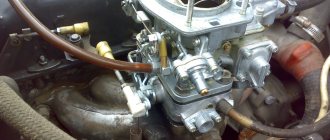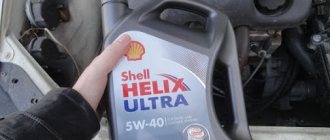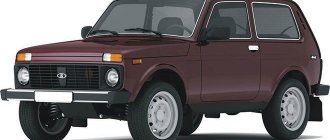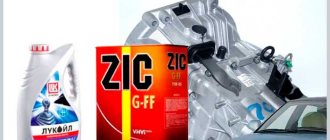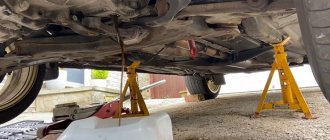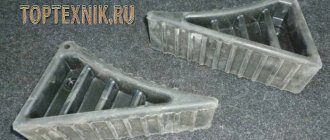01/24/2022 2,573 Lubrication system
Author: Victor
Correct operation of a car engine is possible only under conditions of constant lubrication of its internal components and parts. In this article we will look at how the Niva Chevrolet oil is changed and in what cases the lubricant must be changed.
[Hide]
Replacement frequency
In accordance with the official maintenance and operation manual, the frequency of changing synthetic or semi-synthetic fluid in the Chevrolet Niva engine is one year or 10 thousand kilometers. After this, this substance loses its properties and cannot properly lubricate the rubbing components of the engine.
What signs can be used to determine the need to replace synthetics or semi-synthetics in the Niva internal combustion engine:
- there were difficulties starting the engine;
- the power unit began to operate more noisily, and sounds uncharacteristic of its operation appeared;
- the engine began to vibrate and oscillate;
- the lubricant level has dropped and is now below normal;
- traces of deposits and dirt have appeared in the oil, which can be seen on the dipstick.
The service life of the lubricant is determined by several factors:
- Terms of use of the car. If the vehicle is operated in a large, dusty city, this will reduce the service life of the lubricant.
- The quality of the fuel filled into the car. If the fuel contains more sulfur than necessary or the gasoline does not meet the standards, the performance properties of the consumable material are reduced.
- The quality of lubrication is also affected by year-round operation of the machine. This leads to a decrease in the characteristics of the liquid due to temperature changes, air humidity and other nuances.
You can learn in detail how to properly change the lubricant in a Chevrolet Niva engine from a video filmed by the user Village Citizen.
Which oil should you choose?
How to choose the right oil? The manufacturer recommends looking at the operating instructions. The manufacturer recommends using domestic motor oil, LLK-International LLC, Angarsk Petrochemical Company OJSC.
Auto mechanics recommend using oil from foreign manufacturers:
- SHELL;
- Castrol;
- Exxon Mobil Corporation;
- Ravenol;
- SK Lubricants.
The correct choice of engine oil should be based on the operating conditions of the vehicle.
Selecting oil and filter
If you decide to make the replacement yourself, it will be useful to find out which engine oil is best to pour into the engine in summer or winter. The substance recommended by the manufacturer for filling into Chevrolet Niva diesel engines with hydraulic compensators must comply with class 5W30 of the SL/CF standard. This lubricant is poured into car engines from the factory. The main thing is that the product has passed Euro 4 safety class tests. To choose the best oil, we recommend that you read reviews from other Niva car owners. In fact, lubricants corresponding to API, SJ, SH, SG classes can be poured into power units. As for the viscosity standard, it is selected taking into account the temperature range of use of the machine. The best option for Niva Chevrolet is considered to be Mobile Super 3000 lubricant.
The following products can be used:
- Lukoil 10W40;
- Shell Helix with viscosity grade 5W30 or 10W40;
- Petro Canada;
- Castrol;
- Gazpromneft, etc.
The service life of the oil filter corresponds to the service life of the lubricant, so if you decide to change the fluid, you must also change the cleaner. In the production of cars, Salut filter devices with article number 2108-1012005 are used, so many experts recommend choosing this particular product. It is possible to use MANN W920/21 purifiers with a height of 7 cm or SCT SM 102 devices. All of the listed filter options are equally effective.
How much oil should I pour?
Now let’s figure out how many liters of liquid should be poured. In Chevrolet Niva cars with an engine capacity of 1.7 and 1.8 liters, about 3.5-3.75 liters of lubricant must be poured. To complete the task you will have to purchase a four-liter package.
The Garazhnik channel published a video that shows step by step the process of changing consumables in domestic Chevrolet Nivas.
Level control
The procedure for monitoring fluid volume should be carried out on a cold engine:
- Open the hood of the car and find the inspection hole where the meter is installed.
- Remove it from its seat and wipe it with a rag.
- Reinstall the dipstick into the neck of the inspection hole and pull it out. If the lubricant level in the machine’s engine is normal, traces of oil will be located midway between the MIN and MAX marks on the meter. At a lower volume, it is recommended to check the tightness of the lubrication system. A critically low engine oil level may indicate a serious leak.
Choosing an oil filter
High-quality cleaning of engine oil will allow you to filter out as completely as possible solid particles that enter the liquid as wear products of rubbing surfaces. Therefore, you should not save when buying a filter element.
For the 1.7 engine, a filter element is produced - MANN-HUMMEL with index W 914/2. Be careful, the filter W 920/21, which is similar in mounting, is intended for similar engines, but with a volume of 1.6 liters.
The filter for the 1.8 liter engine will not be equal in size to the previous one. This is due to the lower rate of oil pumping. At the same time, due to the rarity of the engine, purchases of “consumables” are carried out individually according to the catalog or VIN number of the car.
How to replace it yourself?
Changing the oil in a Niva Chevy engine with your own hands is not so difficult. You will need a garage with a pit or overpass, as well as detailed instructions. Below we will look step by step how to replace the lubricant in the engine.
Tools and materials
Having purchased the required volume of oil for filling with a filter, you need to additionally prepare the tool:
- clean rags;
- a cut-off bottle or old bucket (any container into which used lubricant can be drained);
- iron brush;
- a device for dismantling the cleaning device; if it is missing, you can remove the filter using improvised means;
- screwdriver;
- hexagon for unscrewing the drain plug;
- watering can or funnel.
The Car Lover channel has provided a video showing the procedure for changing lubricant and cleaners in a Niva Chevrolet car.
Algorithm of actions
How to change the lubricant yourself:
- The replacement procedure is carried out on a warm engine, this will allow the heated oil to drain as much as possible from the system. The machine is driven into a garage with a pit for work.
- Open the hood of the Chevrolet Niva. Locate the filler neck; it is located on the cylinder head. Unscrew the plug.
- Under the bottom of the car you will see the power unit crankcase protection; it must be removed. To dismantle, unscrew all the bolts that secure it. Make sure there is no oil in it. Under the protection you will see a drain cover. If there is dirt on it, clean the plug with a brush or rags. Place a cut bottle or other type of container under the drain hole.
- Using a wrench, unscrew the plug. At first, the liquid will flow out of the hole with a slight pressure, but after the lid is finally opened, oil may splash out, so we recommend using gloves. Wait until the used lubricant has completely left the Chevrolet Niva engine. When the draining is complete, screw the plug into place, but before doing so, assess the condition of the seal. If it is worn out or cracked, it is recommended to replace it.
- Assess the condition of the drained liquid. If you find traces of deposits and dirt, as well as wear products (metal dust, pieces of rubber), it is recommended to flush the lubrication system. It is also necessary to flush when switching from one brand of motor fluid to another.
- If cleaning the engine is necessary, you will also need four liters of flushing oil. Lubricant is poured into the engine and the filler plug is tightened. Start the engine and drive the car for several kilometers. Drain the flushing oil and assess its condition. It should be cleaner. If there are no wear products left, then you can proceed to the next stage. If there are deposits in the flushing oil, the cleaning procedure should be repeated.
- Locate the installation location of the cleaning device. If you have a puller, then remove the filter using the tool. If you don't have a key, try unscrewing the device by hand. If nothing comes out, take a screwdriver and use it to pierce the filter housing as close to the bottom as possible. When punching, it is important not to damage the thread on which the cleaner is installed. Once the screwdriver is past the filter housing, use it as a lever. You can use a bicycle chain by wrapping it around the cleaning device and turning it counterclockwise.
- About one hundred grams of lubricant should be poured into the new filter. It is recommended to lubricate the rubber located in the thread area with a drop of oil. This will prevent it from sticking and problems during further dismantling of the device. Install the filter into its seat by screwing it clockwise. Do not over-tighten the device.
- Install the watering can into the engine filler neck. You must pour liquid into the power unit carefully so as not to spill. The volume of lubricant in the internal combustion engine is monitored using a meter. Ideally, the fluid level should be between the MIN and MAX marks. After filling, the neck plug is tightened.
- Start the car engine and let it idle. The engine should warm up.
- After starting, the engine oil pressure warning light may light up on the dashboard in the cabin. It should turn off automatically after a few seconds.
- Make sure there is no lubricant leakage.
- Let the engine cool, then check the volume of the substance in the power unit again. If necessary, add fluid to the internal combustion engine.
Photo gallery
Photos of replacing the lubricant are shown below.
Using a socket wrench, unscrew the drain bolt
Open the hood and unscrew the filler cap
Remove the cleaning device and replace it
Step-by-step replacement instructions
Required Tools
You will need the following supplies, parts and tools:
- New filter and oil;
- L-shaped hexagon;
- Container for draining old fluid (volume - at least 4 liters);
- Rags or rags.
Work order
1. Place the car on a lift, inspection ditch or overpass; 2. Start the engine, warm it up to operating temperature and turn it off after 10-15 minutes; 3. Open the hood and remove the oil filler cap by turning it 90 degrees counterclockwise; 4. Using rags or rags, clean the drain from any dirt that has accumulated there; 5. Remove the engine splash guard and crankcase protection. 6. Remove dirt from the drain plug using a wire brush, and then wipe the oil filter with a rag; 7. Using a hexagon, unscrew the drain plug and immediately replace the container;
Attention! Be very careful, the oil will be hot.
8. Wait 10-15 minutes for the oil to drain completely; 9. Unscrew the old oil filter, you may be able to do this by hand, otherwise you will have to use a special puller; 10. Take a new filter and fill it 60-70% with oil so that when you first start the engine runs for a minimum amount of time in oil starvation mode; 11. Lubricate the rubber ring on the filter with oil and screw it into place; 12. Tighten the drain plug and fill in clean oil, monitoring its level (remember that the recommended standards are 3.5-3.7 l); 13. Start the engine and make sure that the oil pressure sensor goes out; 14. Let the engine idle for 10-15 minutes; 15. Inspect the oil filter and make sure there are no leaks.
What will happen if you don't change?
Lack of oil or the use of low-quality fluid can lead to serious problems, including major engine overhauls. Due to poor quality lubrication of moving parts and components of the motor, faster wear of the elements occurs. This causes them to fail faster. If the oil is not changed on time, its level in the engine decreases due to the fact that part of the liquid goes into deposits. This can lead to a change in pressure in the lubrication system and squeezing out oil seals and seals.
Oil that has reached the end of its service life may become carbon deposits. As a result, deposits form on the internal walls of the engine, which can ultimately cause increased fuel consumption.
Advice from motorists
Regardless of the mileage of the engine and its condition, changing the oil on a Chevrolet Niva yourself must be done in a timely manner and with high quality. There is no need to bring the engine to a critical state and constantly operate it at the limit of its capabilities. In this case, you can count on long-term operation of the car’s internal combustion engine. From all of the above, certain conclusions can be drawn. For normal engine operation, you need to use lubricants recommended by the manufacturer, change the lubricant on time, and check the level before each trip. All this will help preserve and extend the life of the heart of the car for many years.
Video “What the process of changing the lubricant looks like in a Chevrolet Niva”
User Vitaly Bordyugov provided a video that clearly demonstrated the procedure for independently changing engine oil in a Niva Chevrolet engine.
Do you have any questions? Specialists and readers of the AUTODVIG website will help you ask a question
Was this article helpful?
Thank you for your opinion!
The article was useful. Please share the information with your friends.
Yes (100.00%)
No
X
Please write what is wrong and leave recommendations on the article
Cancel reply
Rate this article: ( 3 votes, average: 5.00 out of 5)
Discuss the article:
Mineral or synthetic
When choosing a specific oil for their Chevrolet Niva, a significant part of car owners are clearly inclined to save money. Of course, a lot depends on the availability of financial resources, but if you have about half a million rubles to buy a car, then you can also buy a canister of decent oil, but again this is a subjective matter.
Returning to the choice of the two main existing types of motor oils, it is worth immediately clarifying that mineral oil is almost impossible to purchase, and even if you can get it, it has extremely poor characteristics, burns out faster and shows poor quality of lubrication of engine parts, although it is definitely cheaper. But since we treat our Niva with due respect, therefore this category will not be analyzed, why ruin the car ahead of time.
Average rating:
4.17 ( 6 out of 5)
